Call 0437 805 220 | email drshaan@vetalign.com.au | South East Queensland
Equine veterinary dentistry goes beyond just removing sharp points. It’s a thorough medical examination to identify and treat underlying dental issues. Every routine dental I perform is done under sedation, with a speculum, a flushed mouth, excellent lighting, and a mirror to ensure a comprehensive and effective assessment
"What you can't see -you can't diagnose, and what you can't diagnose - you can't treat."
I don’t recall who originally said this, but it’s a phrase my dentistry mentor made sure I never forgot. It highlights the importance of a thorough exam—because even ponies with giant hooks, like the one pictured below, can still appear to be eating well and maintaining weight.

What to Expect from a Dental Visit with Me
I aim to make your horse’s dental experience as thorough and stress-free as possible. Here’s what you can expect during a visit:
Preparation
It’s helpful if your horse is ready when I arrive and if there’s an undercover area to work. A shaded or sheltered space ensures I can use my light more effectively to see everything in the mouth and protects us from the Queensland weather. If that’s not possible, no worries—I’ll make it work!
Duration
Safety & Sedation
Before starting, I’ll perform a physical exam to ensure your horse is fit for sedation. If your horse has a heart murmur or a history of headshaking during dentals (often due to pain), I’ll adjust my sedation protocol to suit and/or add in pain relief. Sedation lasts around 40 minutes. After the dental, it’s best to avoid hay or hard feed for an hour, as sedated horses aren’t great at chewing and could choke.
For Kids and Pets
I love showing kids what I do and letting them feel the teeth—it’s a great learning experience! However, dogs can mistake me for the farrier and get underfoot, so it’s safest to keep them secure during the appointment.
Equipment
I use two headstands—one for minis and one for larger horses—so your horse can comfortably rest their head without you or me holding up heavy necks. Starting in 2025, I’ll also have a mobile crush with built-in scales to get an accurate weight for your horse. If your horse doesn’t lead or load, we can stick to the headstands—no problem!
Examination
Every dental starts with an external head exam. I assess muscle development, any lumps or bumps, and occlusion (how the teeth align and fit together). As part of my biomechanical medicine practice, I also check the TMJ (temporomandibular joint) and gently assess the OA (occipito-atlantal) joint for mobility.
Tools & Techniques
Treatment
Sharp points are removed, and remedial floating is carried out on hypererupting teeth, wave mouths, or hooks. I encourage owners to look and feel the teeth during the process, but if that’s not your thing, that’s completely fine!
Final Steps
After the procedure, I flush the mouth thoroughly. Your horse can then have a little nap while the sedation wears off. Remember, no hay or hard feed for an hour post-dental to avoid choke.
This procedure applies to routine performance dentals for horses with regular dental care. For more complex cases, wolf teeth extractions or specific concerns, additional time and care may be required.
Let’s work together to ensure your horse’s dental health, comfort, and performance! 🐴✨
Horses should have a dental exam at least once every 12 months. Horses under 5 years old or over 20 years old, should have dental checks every 6 months. Young horse mouths have a lot going on with adult teeth erupting, “caps” being shed and sharp points causing mouth ulcerations. Older horses can have undiagnosed dental disease, weight loss and poor occlusion.
Horses with “interesting” mouth and dental pathology may need even more frequent checks.
Pairing these with a physical exam, annual vaccinations and/or baseline bloodwork can help you stay ahead of any potential health issues.

Wolf teeth are small, vestigial teeth located in front of the first cheek teeth, commonly found in horses. While not all wolf teeth cause issues, they can interfere with the bit, leading to discomfort or behavioral problems. Extraction is often recommended for young horses being started under saddle or for horses showing signs of bit-related discomfort. The procedure is straightforward and performed under sedation and with local anaesthetic to ensure the horse’s comfort. Prompt removal when younger (2 or 3 years) minimizes complications.
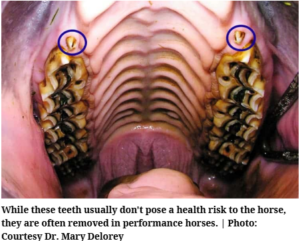
Hooks
Hooks occur when a horse’s teeth are misaligned, causing uneven wear and sharp points to develop, typically at the front of the upper cheek teeth or the back of the lower cheek teeth. These can interfere with chewing and bit comfort, leading to pain and reduced feed efficiency if not addressed.
Ramps
Ramps are steep, sloped overgrowths that usually form on the first or last cheek teeth due to improper dental alignment. They can restrict the natural motion of the jaw, causing discomfort and potentially leading to issues such as weight loss or difficulty eating.
Wave Mouth
Wave mouth describes an uneven chewing surface along the cheek teeth, resembling a wave. This condition often develops over time due to improper wear or neglected dental care and can interfere with efficient chewing, leading to food packing, discomfort, and even long-term dental complications.
Regular dental care is essential to manage and prevent these conditions, ensuring your horse’s comfort, effective chewing, and overall health.
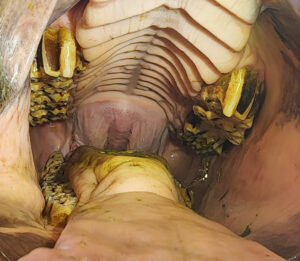
Toggle Content
Peripheral Caries
Peripheral caries typically affect the outer surfaces of the mandibular (lower) cheek teeth. This form of decay is often linked to dietary factors, such as high-sugar feeds or forage, and water quality issues. Decaying teeth can lead to discomfort, reduced chewing efficiency, and increased risk of infection if left untreated.
Infundibular Caries
Infundibular caries are developmental and occur in the upper cheek teeth, specifically on the occlusal (grinding) surfaces. Over time, this decay can weaken the teeth, increasing the risk of fractures.
Regular dental examinations are essential to identify and address caries early, preventing complications and ensuring your horse’s comfort and performance.

Periodontal pockets are deep gaps that form between a horse’s teeth and gums due to gum disease or food impaction. These pockets can trap feed material, leading to inflammation, infection, and pain. Over time, untreated periodontal pockets can cause gum recession, tooth loosening, and even tooth loss.
Common causes include poor dental alignment, gaps between teeth (diastemata), and diets that promote food packing. Regular dental checks and appropriate management, such as cleaning the pockets and adjusting the diet, are crucial to prevent further damage and maintain your horse’s dental and overall health.
Periodontal pockets in horses can also be caused or worsened by bot fly larvae (bots). Bots can embed themselves in the gums around the teeth, causing irritation, inflammation, and damage to the soft tissues.
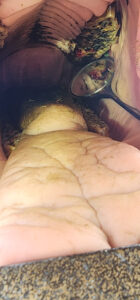
Flushing out periodontal pockets and diastemata packed with feed is a vital part of managing gum health in horses. This procedure involves cleaning out trapped food and debris from the pockets to reduce inflammation, prevent infection, and promote healing.
I use the Equus Jet Water Pick is an advanced tool designed specifically for equine dental care. It delivers a high-pressure water stream to effectively and gently flush out periodontal pockets, even in hard-to-reach areas. This precise approach ensures a thorough clean while minimizing discomfort for the horse.

An oroscope examination is a cutting-edge tool for equine dental care, designed to enable a thorough evaluation of the oral cavity and dental arcades. This technology provides high-quality video and photographic imagery, allowing for clear and precise diagnoses of dental issues, such as microfractures, early decay, gum disease, or irregular wear patterns.

✅ Clear and Precise Diagnosis: Enhances accuracy by revealing subtle problems not visible during standard exams.
✅ Better Patient Follow-Up: Documentation with images and videos supports ongoing care and progress tracking.
✅ Improved Owner Understanding: Clear visuals help owners see and understand the horse’s dental condition, fostering informed decisions about care.
I use an oroscope to ensure comprehensive examinations and better communication, leading to optimal dental health and performance outcomes for your horse.

Dental X-rays are an invaluable tool for diagnosing and managing equine dental health. They provide detailed images of the teeth, roots, and surrounding bone structures, revealing issues that are not visible during a standard oral exam.
X-rays are particularly useful for identifying conditions such as tooth root abscesses, fractures, impacted teeth, and bone changes associated with infections or dental diseases. They also aid in planning treatments like extractions and monitoring ongoing dental health.
This non-invasive diagnostic tool ensures precise and effective care, improving outcomes and enhancing your horse’s comfort and well-being.
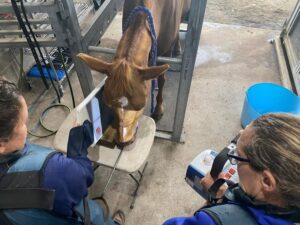
Generally I refer extractions to excellent specialists as they can be complicated, long and tricky to do in the field. However I can do extractions, and may be able to offer this in some cases.
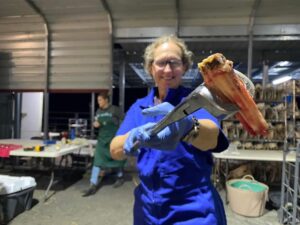
If you are curious about equine dentistry and want to know more, Dr Elizabeth Thompson has written an excellent book – buy it at the link below:
Modern Equine Dentistry for Horse Owners
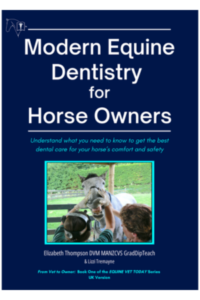
If you have additional questions or concerns not addressed here, please feel free to reach out.
Please feel free to also reach out at: